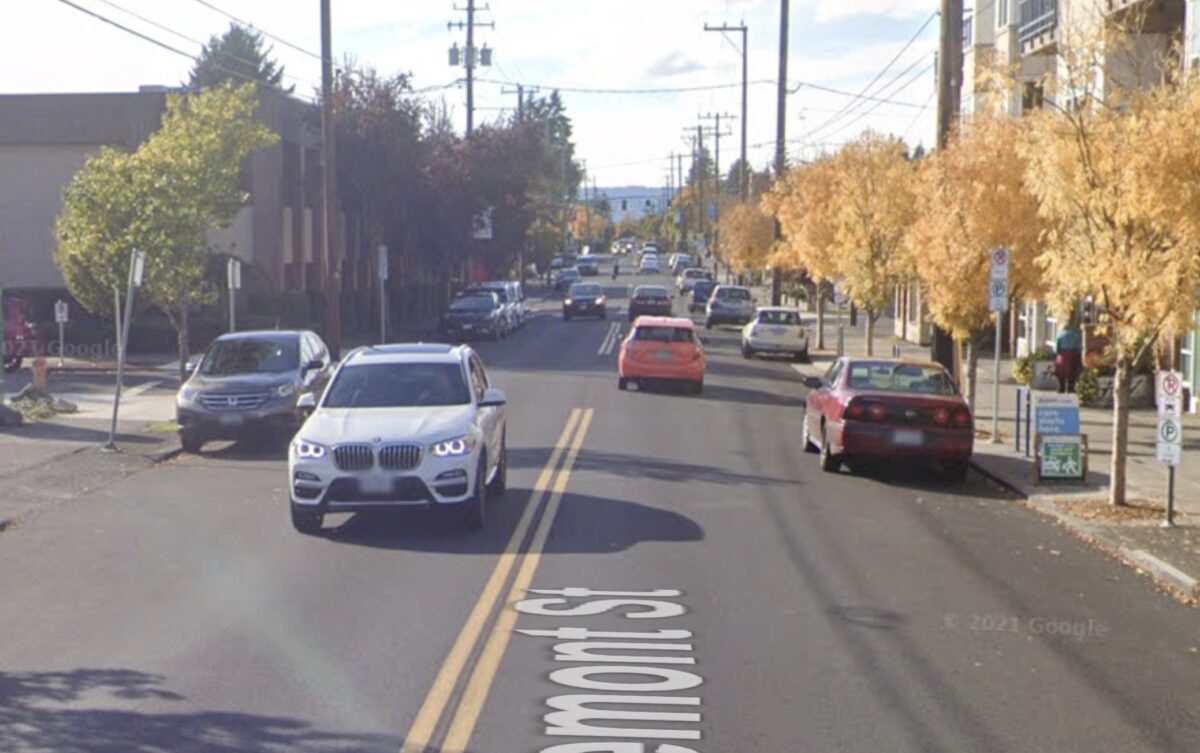
A bustling commercial section of NE Fremont in the Beaumont-Wilshire neighborhood was the location of Portland’s most recent traffic tragedy.
According to the Portland Police Bureau, two people walking near the intersection of NE Fremont and 44th (map) were struck by someone driving a car just before 6:00 pm Tuesday night. One of the people died on the scene and the other is still in the hospital with what PPB says are life-threatening injuries. The driver is now part of an ongoing investigation by the PPB’s Major Crash Team, who are still looking for tips from witnesses who might have seen what happened. If you have anything to share, please contact crimetips@portlandoregon.gov and include Traffic Investigations Unit case number 21-354996 in your message, or call (503) 823-2103.
Further official details have not been released, but a source (below) says the people were in a crosswalk when the collision occurred.
Advertisement
This section of Fremont is in the heart of the Beaumont shopping area. The lane configuration is typical of small Portland main streets: One general use lane in each direction and on-street parking on both sides. All the cross streets in this area are off-set, meaning they come to a “T” at Fremont instead of making traditional, 4-way intersections. With parking on both sides of the street, relatively narrow road width, off-set intersections, and dark and rainy conditions, this location can be very difficult to navigate. The posted speed limit is 20 mph.
BikePortland reader and transportation advocate Bjorn Warloe is very familiar with this section of Fremont. He shared his thoughts on Twitter last night,
“Tons of parking and offset streets make sketchy crossings and if you want to use a light you have to walk either to 42nd or 57th, which are 3/4 of a mile apart. If the city was serious about safety here they would remove most if not all parking and replace it with wider sidewalks so the street would be the same width but with much better visibility. Crosswalks could also be elevated to the same grade as the sidewalk. Instead it is signed as 20 mph but many routinely go faster and I am actually passed several times a year by cars going closer to 40.”
This horrific and tragic death is the 66th fatality on Portland streets so far this year. That’s the highest number of deaths since 1972. 28 of them were walking. So far no bicycle riders have been killed.



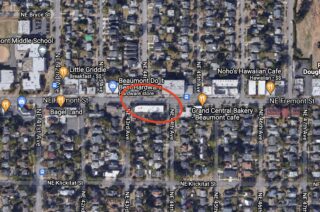
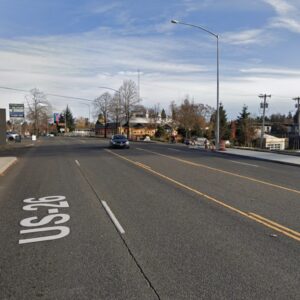
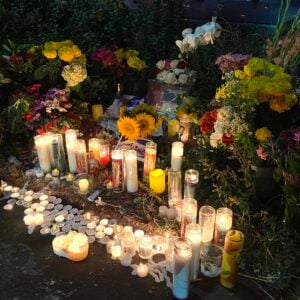
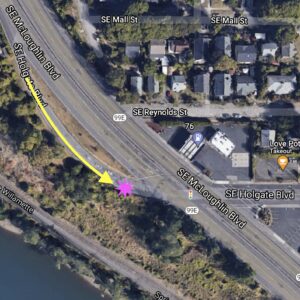

Thanks for reading.
BikePortland has served this community with independent community journalism since 2005. We rely on subscriptions from readers like you to survive. Your financial support is vital in keeping this valuable resource alive and well.
Please subscribe today to strengthen and expand our work.
Thanks again to Wheeler, Hardesty and the gang who are making the streets safe…
Hardesty could throw some orange barrels in the middle of Fremont. Maybe that would help.
The driver was the one making fatal choices, not Hardesty, unless you’ve heard something from PPD that we have not. Which is possible.
There are many many places in Portland, like the end of my block (next to the Montessori school) where people in charge of motor vehicles choose to drive 15 or 20 mph over the posted limit. Sure, put it on Hardesty.
We can’t expect anyone to stop speeding with zero traffic enforcement. Hardesty and other activists in Portland have said we cannot enforce traffic laws, or install speed cameras because they disproportionately affect minorities.
No one has said that Chris I. Why on earth would you say that? Hardesty has said all along that she wants cops to enforce traffic violations. She and many activists are also very supportive of cameras.
Why the constant defense of a person who clearly is bad at her job?
So is Wheeler. Ryan, all of them. Yet you constantly bristle at any criticism of Joann.
Performative outrage or something… she is a terrible manager and along with Ted, has allowed the city to completely unravel in the last few years.
Do you think things are going well in Portland?
I’m stating facts. Don’t drag me into a position I don’t hold.
https://www.wweek.com/news/city/2019/07/11/city-commissioner-jo-ann-hardesty-fears-vision-zero-traffic-stops-will-be-weaponized-against-people-of-color/
Remember this? Apparently not, she literally said that enforcement overly affects minorities and was not for increasing any enforcement until there were other changes made. Oh, and she also said pedestrians needed to be paying attention better rather than the lunatic drivers. So, maybe Chris I was slightly hyperbolic, but far less so than the hysteria of, “Why on Earth would you say that”, because its really not a stretch.
Yes I remember that. I also know that article is from JULY 2019. She has changed her stances considerably since then. It is now a fact that Hardesty supports police and automated enforcement of violations and she is also very concerned about policing that harms specific communities more than others.
Maybe my reaction to Chris wasn’t the best… I just feel like some people are being willfully ignorant of Hardesty’s stances because they don’t like her in general. I think our discussions are much better when everyone has the facts and respects the nuance and complexity of these issues.
If she hasn’t said it, others have, as have many of the loudest voices on the left. Defund the popo? Remember that? Reap what you sow?
If even 20% of car drivers in Portland consistently observed speed limits it would radically change our streets. It feels distinctly odd to drive a modern car at 20 mph but you can do it.
It wouldn’t disproportionately affect minorities if cops weren’t racist. I see mostly white people driving badly, truth is the Police don’t want to pull them over and are using concerns about racism as an excuse to do nothing, until people beg for authoritarianism.
Heartbreaking! The silver lining is that there are many solutions – many of which Bjorn mentions. But will the city have the courage to act boldly in making streets designed for people rather than car throughput?! This has been and continues to be the central question.
My gut says no, the city will not make the kind of changes (parking removal) that Bjorn calls for in the story. I live in this neighborhood and have zero belief that the businesses and the residents would go for parking removal on Fremont. The side streets are already packed with people parking so they can shop and eat on this lively stretch of Fremont. More parking “in the neighborhood” is not going to go over well, sadly. Even in light of this tragedy.
I just wrote Hardesty an email urging her to push for safer streets. It is just an email, but it is more than doing nothing. I am saddened and shocked by this death; I live close by and visit this part of Fremont regularly. This street — and many others, like Hawthorne, Division, etc. — are designed to be dangerous, and the result is predictable.
Vision Zero now means zero enforcement and zero consequences, since zeroing out the traffic enforcement budget. Our left wing city government monoculture = death.
Irresponsible people driving overpowered machines without reckoning the human cost of their mistakes = death.
Groupthink at it’s best. It’s the Portland Way.
I’m guessing that even though the driver “stayed at the scene and cooperated with the investigation,” there will be no consequences for them. Oh, maybe higher insurance rates, if they even have insurance.
Given that the speed limit is 20mph, it’s an area with known high level of pedestrian traffic, and the people walking were in a crosswalk, will this be enough for a charge of vehicular manslaughter, or at the very least, be enough to check the VRU box?
Nope.
I find it interesting and frustrating that the traffic division has zero budget for enforcement, but still retains the major crash team to investigate crashes.
When bicyclist Mark Angeles was killed by a left-turning tow truck, the major crash team pulled out all the stops to do the investigation and “proved” that Mark may have been exceeding the posted speed by a couple mph. He was 56 feet from the intersection when the light turned yellow. The tow truck driver received a $200+- citation for failing to yield on her left turn.
What is the point of doing a thorough investigation if nothing significant will be learned and nothing will be done in response? It seems like a continuation of Portland’s emphasis on “studying” rather than “doing.”
Just how long would it take to conclude that 1) the driver was likely driving too fast for conditions, even if he/she was driving below the posted 20 mph speed; 2) the visibility of the crosswalk was limited by parked cars; 3) street lighting is marginal or inadequate due to pole placement and interfering vegetation; and 4) the pedestrians were not highly visible, perhaps due to their selection of clothing?
Are we going to do anything with the information? If the answer is “no,” why bother?
The severity of the injuries makes the driver obeying the 20 MPH speed limit unlikely, especially considering that both victims had life-threatening injuries. I have a graph of speed vs injury and death in motor vehicle wrecks against pedestrians. The data point for 20 MPH is 95% survive, >80% walk away.
PBOT has refused to consider raised crosswalks (for at least a decade) even though these are among the best validated pedestrian crossing infrastructure in several European nations.
DC city council members have recently introduced legislation that proposes widespread use of raised crosswalks so, perhaps, there is some hope that the the USA will start legalizing this basic pedestrian infrastructure:
https://wjla.com/news/local/dc-council-pedestrian-safety-crashes-crosswalks-proposals-ddot-traffic-cameras
It is somewhat concerning that Bjorn did not mention pedestrian safety islands. Despite abundant evidence that median safety islands greatly decrease pedestrian risk, some advocates have criticized or, even, dismissed this key pedestrian safety infrastructure. In the context of a transportation agency that has a long history of not prioritizing pedestrian safety, the perfect is the enemy of the good.

https://safety.fhwa.dot.gov/provencountermeasures/ped_medians.cfm
Both raised crosswalks and pedestrian safety islands do not require wholesale parking removal so it’s misleading to suggest that this is a requirement.
I see what you mean. Raised median going in but not a raised crosswalk for the Killingsworth safety project (story linked below). Is it auto driving ease that is being protected? https://bikeportland.org/2021/12/22/750000-in-state-grants-coming-to-pbot-for-three-safety-projects-342751
Yes, SUV/truck-driving ease is PBOT’s priority and PedPDX is performative BS, like so many of Portland’s “plans”.
I should clarify: PedPDX like the 2030 bike plane is full of good stuff but is essentially unfunded (zero binding commitments) and grossly insufficient infrastructure will dribble out slowly at the vagaries of Portland’s feckless elected officials until PBOT staff is so embarrassed at the lack of progress that they no longer even discuss it with their Bureau commissioner.
I love seeing the illustrations in your link of the raised crosswalks, and the related raised intersections and continuous sidewalks. They transform the crossing experience in a way other safety features (lighting, signals, markings, etc.) do not. With those, people crossing are still leaving the sidewalk environment and stepping down into the street surface–leaving the pedestrian realm and entering the vehicle realm. When the crossing is raised and the asphalt street surface is changed to sidewalk material, the feeling is that vehicles have left their realm and are passing through the pedestrian realm.
It raises the question of whether the term–and whole concept of–“crossing” is wrong. “Crossing” reinforces that people walking are leaving the pedestrian area (sidewalks) and crossing through the vehicles’ area. Why not turn it around, and view intersections as the area where vehicles cross the pedestrians’ area? Instead of “I walked along the sidewalk and crossed the street at the intersection” it would be, “I drove down the street and crossed the sidewalk at the intersection”.
Currently, if someone walking gets hit crossing the street, the view is that the pedestrian left their area (the sidewalk) and was struck by a vehicle in the vehicle area (the roadway). Instead, view it as “the pedestrian was struck by a vehicle crossing the pedestrian zone”. Instead of people walking in crosswalks, there would be people driving in crossdrives. It may sound crazy, but it’s really how things should be at neighborhood centers like Fremont, Hawthorne, etc.
The raised crosswalks/raised intersections/continuous sidewalks move things in that direction in a way other approaches do not.
In bonafide democracies with some semblance of social cohesion raised crosswalks are even paired with median safety islands AND speed bumps.
While I share the frustration that we don’t use raised crosswalks more often, it’s not true PBOT refuses to consider them. They are found in Portland. For example, here at SE 42nd and Gladstone.
Thanks. I was wondering if there were any. I’d love seeing an article that showed them all. (The existence of a handful doesn’t really contradict soren’s point.) Here’s one in Willamette Park (Parks, not PBOT) that avoids the awkwardness in your example of having to go down a curb ramp then immediately back up in order to accommodate drainage: https://www.google.com/maps/@45.4731831,-122.6704528,3a,75y,153.97h,95.06t/data=!3m6!1e1!3m4!1sd-Fh8U5NcCTubimnD6iOUw!2e0!7i16384!8i8192
Thanks for a bit of hope, Steve B.
It’s great to see that PBOT is installing this kind of infrastructure (this is fairly recent, I believe) but it should be a default treatment in areas with higher levels of pedestrian traffic.
I didn’t raise the idea of a protected median largely because the street is narrow compared to the example photo you linked. Another option instead of widening the sidewalks after removing the parking would be to move the travel lanes out and place a median in the street. You could not install pedestrian islands on this section of Fremont without significant parking removal though.
Ladies and gentlemen….. incrementalism.
Brought to you by political convenience, ignoring the deaths of houseless people and the makers of paint.
Incremental…impunity.
[deleted my comment]
Don’t know anything about the driver here but I’d like to see a breakdown by age of the driver. I have a sneaking suspicion that aging boomers are reeking a lot of havoc out there but feel unable to give up their car centric lifestyles. I’ve had a couple such incidents, especially after dark.
A google search of automobile crash statistics by age will quickly reveal that drivers in their 60s have the lowest crash rate, injury rate, and fatality rate per mile driven. Even those in their 70s are safer than those in their 20s. Sorry, but your suspicions are simply wrong. Maybe you’ll learn about age discrimination – eventually.
Older drivers were overrepresented in a variety of
types of crashes consistent with findings from previous
studies. The patterns of overrepresentation were generally
similar in the FARS and GES data. Drivers 70 and older, and
particularly those 80 and older, were overrepresented in
intersection crashes. Intersections controlled by stop signs,
and to a lesser extent, traffic signals, posed particular hazards
for drivers 70 and older. The GES data provided evidence
that older drivers experienced severe injuries and fatalities at
higher rates than other age groups.
https://www.nhtsa.gov/sites/nhtsa.gov/files/811495.pdf
Were they crossing Fremont? If they were at 44th, then they were within 2 blocks of the light at 42nd, right?
It is difficult for car drivers to see ANYTHING at night with oncoming headlights blinding them. More so for older drivers due to deteriorating eyes. Also, the lack of policing of insanely bright headlights makes it worse, and the fact that SUV and pickup lights are high and shine down DIRECTLY into the eyes of oncoming drivers in cars TOTALLY blinding them makes for a deadly scenario. All headlights should be within a couple of inches of the same height. For higher vehicles, the headlights should be in the bumper. Engineering is a thing. The car manufacturers and NHTSA, etc should try it some time.
100% agree with you on light design. It’s an artificial hazard that could be mitigated somewhat if Oregon had vehicle inspection and a standard for aiming headlights. Unfortunately our market isn’t big enough to have much sway on vehicle design.
People should be able to cross NE Fremont at NE 44th, on foot, without dieing. If visibility is impaired by ANYTHING it is a driver’s duty to slow down. A block or two of open lane is not a reason to accelerate to 35 mph but you see people in Subarus, Teslas, etc. do it all the time. I’m for good street design but it is not socially acceptable to kill people with your mundane personal transportation device.
There are no excuses.
“Were they crossing Fremont? If they were at 44th, then they were within 2 blocks of the light at 42nd, right?”
Why are you asking? Are you implying that they should have walked two blocks to cross at a signal, then another block or two to get back to where they were going (needing to cross several non-signaled streets and driveways in the process)?
What if they’d been crossing at say, 48th? Then to cross at a signal they’d have to walk 6 blocks west to 42nd, or nine blocks east to 57th, then another 6 or 9 blocks to get back.
Plus, a surprisingly high percentage of people hit by cars while walking in Portland are hit while crossing at signalized intersections. Most signalized intersections allow cars to turn right or left across the crosswalk while you’re crossing. If you’re crossing near rush hour, you’re almost guaranteed to have cars driving through the crosswalk while you’re crossing.
Many are also hit in the daytime, when headlights are irrelevant. And if headlight rules were changed today, it would be a decade or more before most cars on the road were compliant. Crossing design, and especially drivers, are much bigger factors than headlights.